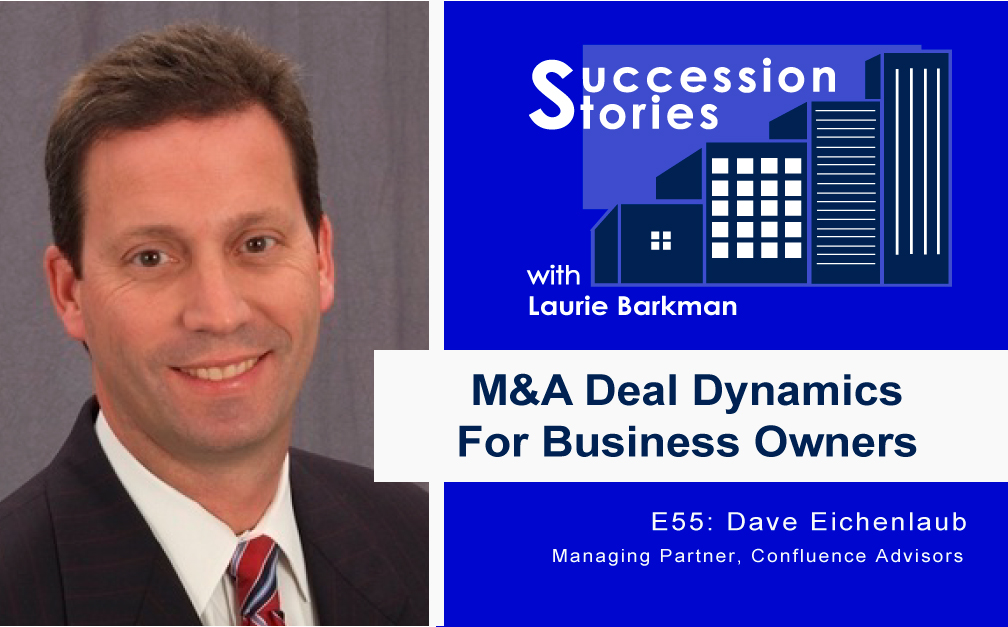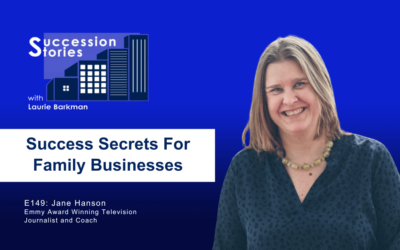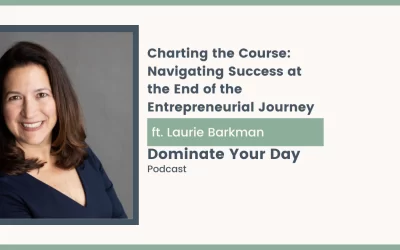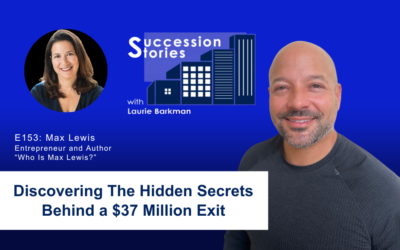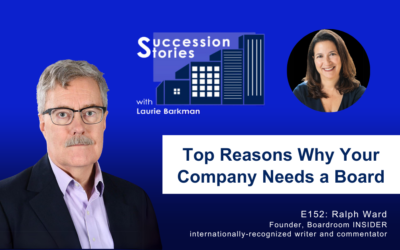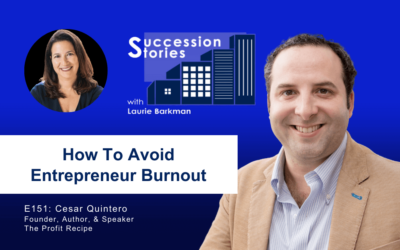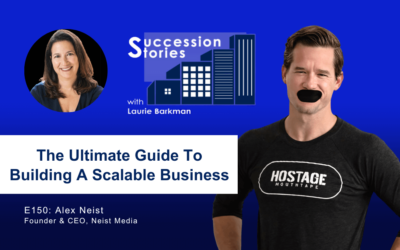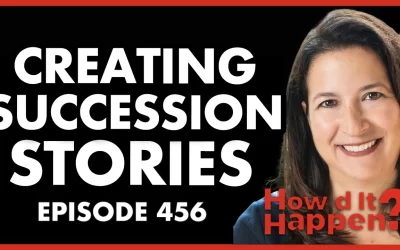For many business owners, selling your company is typically a once in a lifetime transaction. But it’s hard to know how it all works until you’re in it. Laurie Barkman talks with M&A and boutique investment banker, Dave Eichenlaub from Confluence Advisors, about deal dynamics and what makes a business ready for sale. They explore what can make or sink a deal, and the role of trusted advisors to help bring it all together. Listen in to learn more about why pre-planning to get your business ready for sale makes you more likely to generate the best value, and have a successful generational wealth transfer.
Listen in to learn more about:
- What deal dynamics emerged during the pandemic and potential impacts on activity this year
- Timing considerations for a typical merger and acquisition process and what can sink a deal
- The role of trusted advisors in a potential M&A transaction and when they should be consulted
- What makes a business ready for sale
- Forward thinking and pre-planning for a future transition to be successful
Show Links:
Confluence Advisors on LinkedIn
Stream the audio
Watch the video interview
Transcript
Laurie Barkman:
Dave Eichenlaub, thank you so much for joining me on Succession Stories today. I’m excited to have you here. You are someone who’s going to help us understand the world of mergers, mergers and acquisitions, M&A, and investment banking. There’s probably some people listening who know what those things are, but don’t know a whole lot about them, so that’s why I invited you on the show, because I know you’re going to help us to have a great conversation for buyers and sellers alike. Welcome.
Dave Eichenlaub:
Laurie, thank you for having me. I’m excited to be here today and looking forward to the session today.
Laurie Barkman:
Awesome, thanks. Why don’t we start by you telling us about you. What’s your story? What’s your background? How did you get involved in mergers and acquisitions and investment banking?
Dave Eichenlaub:
Great. So Laurie, my background is in finance and accounting. I worked many years ago as a CPA for one of the big eight firms. Also subsequent to that I worked for a number of national and regional banks involved in corporate lending and I really found myself loving transactions. I guess I’m a deal junkie at heart. So I took that background in corporate banking and accounting and I pivoted into working for a mergers and acquisitions boutique. That was really satisfying, because I got to work more closely with these privately held, family owned businesses and these very important transitions that they undertake. Following that, I was able to pivot from that again, and start my own firm, Confluence Advisors. We started the firm about 12 years ago, almost to the day, myself and three partners, and we’re still together today. We started the firm, Laurie, back in 2009 and if you recall, that was the great recession.
Laurie Barkman:
Not a great time to start a business.
Dave Eichenlaub:
Not a great time to start a business. The merger and acquisition market was in turmoil and nonetheless, we started this firm. We look back now, my partners and I, we say, “What were we thinking, to start a firm during that time?” It was very difficult but we’re very satisfied that we did, we’re very happy the firm has grown since then. We had a firm foundation and we’ve grown the firm very nicely. We’re very thankful and gratified to have the many clients we’ve worked with over the years, they’ve helped us to become really successful. We’ve learned so much in dealing with business owners, hearing their stories, helping them to undertake what’s very, very important, and typically a once in a lifetime transaction. So again, Confluence Advisors – we’re about 12 years old. We worked with privately held businesses, family owned companies through important transitions, acquisitions, sale or capital raising type services.
Laurie Barkman:
That’s a great overview, and the client specifically, are they in certain industries or geography or size at either on the revenue side or employees however you define size?
Dave Eichenlaub:
Sure. Our client base varies. We’re a generalist firm, which means we work with companies in a lot of different industries. We work with manufacturing businesses, service companies, distribution type businesses, testing inspection type companies. We generally work with companies that are 10 million of revenues and North, often 10 million to 100 million of revenues. These tend to be family owned businesses, sometimes second/third generation family owned, sometimes owned by a group of investors or partners. We work with companies, both locally here in western Pennsylvania as well as nationally, we’ve closed transactions all over the country, and we tend to do a fair amount of deals locally as well.
Laurie Barkman:
Gotcha. Let’s start with some definitions, because sometimes people use definitions and terms and then we don’t really know what that means. So would you call yourselves a first and foremost and investment banking firm? Or an intermediary? It’s another term I hear. A broker? What’s the difference between those terms?
Dave Eichenlaub:
We would characterize ourselves as an investment bank boutique. We have five people in the firm, and so we’re not a two or 300 person investment banking firm, like you might see on Wall Street, and we’re also not a lot of brokers. I think that business brokers might work with smaller type companies. We are an intermediary in that we do work on behalf of buyers and sellers to help them go through these transitions. Again, that could be on the buy side, it could be representing sellers in a sale transaction. We’re helping businesses to raise capital through very important transitions as well.
Laurie Barkman:
You’ve been in business for about 12 years. Happy anniversary, by the way. It’s not easy to have business partners, and you’ve had nice consistency. That’s great. So you’ve seen ups and downs, you started at a tough time, you started in the recession of 2009. Obviously, going through some challenges there and then also, in 2020, a very challenging year for a lot of a lot of people, a lot of companies. What deal dynamics did you and the firm observe during the pandemic? How do you think these dynamics are going to continue to play a role this year and possibly beyond?
Dave Eichenlaub:
Great question, Laurie. So we’ve been through a number of business cycles over the years and what happened in 2020, with the pandemic, was different than other recessions. But there are a lot of similarities. So what we typically see is, I think, back to the great recession of 2008 – 2010, merger and acquisition activity is greatly impacted because earnings of companies are impacted and the financing markets freeze up and we saw that last year as well with the pandemic.
Although some of the differences are, the economy was going so strongly, for so many years and merger, advisor activity was rising over the years, selling price multiples have been increasing, the economy was going gangbusters. Financing was very aggressive, then all of a sudden, in March of last year, things came to a grinding halt. One of the big impacts on the M&A environment is called buyer sentiment. When buyers lose confidence, when buyers become risk-averse, it very much affects the M&A market, we saw that drastically. We saw the market impact from a number of different angles. Many companies, their earnings were adversely impacted.
If otherwise, some companies benefited from the pandemic, which we can talk about a little bit later, the financing markets were impacted. Bank financing ground to a halt. Non-bank financing became much more difficult, and very importantly, buyer sentiment changed drastically. So buyers when there’s uncertainty in the market tend to get conservative and this is very bad for the M&A market. What we saw with the pandemic was a number of deals that have been in the works – we ourselves had a couple of deals that were under letter of intent that we thought we would have closed the first half of the year – those deals were greatly impacted by what happened. Thankfully, both have closed subsequently, but they were delayed six to nine months each of those deals.
When buyers see uncertainty, they pull back from the market. We actually had one transaction under letter of intent with a private equity buyer going into the pandemic, and in May, that buyer pulled out of the deal. They got scared. When we think back to that time, it was a very scary time. No one knew what impact this pandemic might have on the economy, on business earnings, so this particular private equity firm pulled out of the deal. They wanted to focus more on their existing portfolio businesses and so we were able to scramble and find a strategic buyer to take their place in the deal subsequently closed. But during the pandemic, the M&A activity almost ground to a halt. For a while, there were very few new deals coming on the market. People weren’t certain what was going to happen.
What we’ve seen since then, though Laurie, is a gradual improvement in the market in many different ways. We’ve seen an improvement in company operating performance, we’ve seen a resurgence of confidence in the economy. We’ve seen people willing to take risks, that is, buyers willing to take risks again and with that we’ve seen the selling price multiples, coming back to a more normalized level. We’ve seen a resurgence in deals activity going into 2021. I think that 2021 should be a very strong year for M&A activity overall.
Laurie Barkman:
There’s a couple of dynamics I wanted to hone in on. They’re also going back to what you said at the beginning, which is, these are privately held companies, many of whom you work with; family businesses, multiple generations. What are some of the reasons why they either want to bring more capital or change the capital structure of the business? Or why are they feeling ready to sell? I guess there’s a general why, but then even more so why now?
Dave Eichenlaub:
Another great question. There are a number of dynamics related to that. The answer to that question, Laurie, typically what we’ve seen after a recession, the business owner sentiment changes. What that means is, and we’ve seen this through various cycles, a business goes into recession and it’s very tough to manage a business through that. When we come out of a recession, the business owners often say, “I don’t want to do that again. I don’t want to go through that again so now I wish to sell.” That’s certainly a factor in a lot of these cases. In other cases, it may be something more specific, maybe an owner is older, and they don’t have family members who want to take over the business. Maybe an owner sees that their business has done really well. The market is strong, which it is now again, and now they’re going to take this time to cash out, so there’s a lot of dynamics involved in that, certainly specific to the ownership structure, but also, in terms of, again, the sentiment of the business owners as well.
Laurie Barkman:
You talked about some of the clients who have manufacturing and where there’s physical assets, and I don’t know if you also deal with technology companies, but those are more digital intangible assets, and both have value. Curious about the manufacturing side or a company that has these physical assets when you’re valuing a business. How do you look at that, let’s say for hypothetically, there’s a company that is 5 million in revenue, but maybe breakeven or less than 10% pre tax income so they’re running a pretty narrow margin there and yet they have capital assets that they’ve invested in; in the physical sense of equipment and buildings and what have you. How do you take a look at that opportunity and give the business owner a sense of what a potential acquirer might look at in that business?
Dave Eichenlaub:
Sure, Laurie. Most businesses will sell based on a multiple of earnings, or EBITDA, so that’s the benchmark, that’s the starting point that is typically used in the marketplace. Then another factor that we would look at is, is the business asset intensive or capital intensive. One may argue that the value of a business is only worth the cash flow and if it takes a lot of capital investment, back in the business that can be viewed as a value detractor. So think of a technology company. Technology companies that have high cash flow ratios, maybe high levels of recurring revenues, and maybe low levels of CapEx would trade for a higher multiple than, say, a manufacturing business that has lower EBITDA margins and high capital requirements. Those are all factors that we would look into. Certainly the asset base of a company is important in valuation, but it’s important in the sense of what cash flow will those assets generate? That’s the most important aspect, and when we see businesses that, let’s say, have very high capital expenditure requirements and therefore very little free cash flow, well, those businesses will trade at a lower multiple. So we like businesses that have diversified. Or, businesses that trade at higher multiples, I should say, tend to have a diversified customer base, high margins, more of a recurring revenue if possible, and lower capital requirements.
Laurie Barkman:
Gotcha. In thinking about capital options for companies, ways to raise capital, there’s been a lot of discussion around SPACs. And I was hoping that you could talk a little bit about that. I don’t know if your firm gets involved or not. But just conceptually, what is a SPAC? I think year over year, the percent of companies using SPAC as a way to raise capital, increased 30% so it’s in the news more and more. I just wanted to touch on that quickly. Any experience that you have with SPACs?
Dave Eichenlaub:
Sure. SPAC stands for special purpose acquisition company. These are publicly traded companies that will merge with a private company. That’s a way for that private company to go public and the dynamics of private companies versus public changes over time. The SPAC error, I should say, which is what we’re in now, has really encouraged a lot of companies to go public and to trade on the public markets. In order to be a public company, you really should have a certain size and growth characteristics, because it’s expensive to be a public company and there are a lot of reporting requirements. Sarbanes Oxley required the officers of that company to certify that the financial statements are accurate, but it’s been a great way for private companies to go public quickly by passing the IPO process and to ride the public companies able to access capital, access more investors than private companies. Typically, though, private companies have been pretty good. Especially over time, the private markets have become pretty efficient, meaning the value of a private company versus the value of that same company if it were public over time, has narrowed. The SPAC era has, I think, changed that but over time, the private markets have become very efficient, and have acted almost more like public companies with the ability from a valuation perspective and ability to raise capital, but certainly a private company doesn’t have that liquidity feature that public companies have.
Laurie Barkman:
Okay, gotcha. Let’s talk about process – how this works. If I’m a buyer, whoever I am – I might be a private equity firm, I might be a strategic buyer – and I’m interested in looking at companies and I’ve now found your firm, and I’ve talked to you and I want to hire you guys. What is the process that you go through to work with a buyer?
Dave Eichenlaub:
Sure. When we look at the market, Laurie, there are way more buyers than sellers so consequently, it’s more difficult to effect and close on an acquisition. When you think of the buyer universe, and you mentioned that you have your private equity firms and your strategic players, private equity players – or we call them professional buyers – they may look at a typical PE firm, let’s say general numbers, 1000 deals in a year, looking to close on a handful, like two or three. So the prospect of buying a business successfully is a lot more difficult than selling a firm. So when we work with buyers and sellers, probably 80% of the work we do is representing sellers. In other words, a business owner comes to us and is looking over their options, maybe not sure what their company is worth in the marketplace thinking about some transition and they’ll hire us to run a sale process. That process, again, the buy side, the sell side, it’s the exact same thing but the other side of the coin. When we’re representing a seller, we are going to that buyer universe consisting of strategic players, financial players, family offices, and we’re making a market for a private company. So we’re taking this illiquid asset, which is a private company, we’re creating a market for that by going to a lot of potential buyers and creating competition for that asset. I said at the start of this, there are many more buyers than sellers so what benefits a seller is when they have a lot of different buyers interested in their business; that drives value. So when we’re representing a company on a sale and talking with 50 to 100, maybe or more potential buyers, we’re trying to create competition for that business. When someone comes to us, seeking to sell their business at that price, from a timing perspective, Laurie, it might take six months, eight months, maybe nine months. In general, it’s a process of creating a compelling selling document for the business and going to the market, creating competition. So when we’re out there representing a company for sale, we’re selling that opportunity to potential buyers, again, that drives value. The best transaction has a number of buyers that really want to bid up the price. We’ve run a number of sale processes where there are 3,4,5,8,10 buyers who really want a business and we’ve seen the impact that can have for the seller in driving value. I mean, we’ve seen some buyers start at a full number of a 20 million value, they’re interested in 20 million. Well, this other buyer may be interested at 22 million, this other buyer 25 million. Before you know it, you’re talking about a 30-35 maybe $40 million transaction. The benefit of that is for the seller, and it’s the competition that can help to drive that value.
Laurie Barkman:
Definitely. Is that an auction environment or that can happen outside of an auction?
Dave Eichenlaub:
It’s typically an auction environment. Some sellers may seek to talk to one or two potential buyers. We typically recommend if you’re trying to maximize the value in a sale, the auction, the sale process, where it’s a very streamlined process where we’re seeking to get these buyers to pit against each other to drive the value – that typically is the auction process.
Laurie Barkman:
Gotcha. What can sink a deal? Why would a buyer walk?
Dave Eichenlaub:
When deals don’t happen, Laurie, probably the biggest reason would be something happened with the seller’s earnings. I’m thinking about the pandemic. For example, a seller in 2019, they’re doing great. First few months of 2020, earnings are very strong and then the pandemic hits. If their earnings declined by 20, 30, 50%, a buyer may walk from a deal and so typically when a deal doesn’t happen, it’s [because] something happens with that seller’s earnings that maybe weren’t foreseen. Maybe they lose a big customer before the transaction and the buyer doesn’t like that and then maybe the buyer wants a purchase price reduction. The seller says, “No, I’m not going to lower the price.” Typically, that’s the number one factor in a deal, why it may not happen; something happens with the earnings. Or maybe something would come up on due diligence. No one knew about it. Maybe there’s a very serious environmental problem with the business that no one knew about that can impact the deal as well.
Laurie Barkman:
How about on the seller side? Do you find sometimes that sellers end up having remorse, so they decide not to not to close?
Dave Eichenlaub:
That can happen, Laurie, and a good succession planning person like you can help to eliminate that. But here’s a story that talks about that. We were hired by a business owner – two brothers who owned a business a number of years ago – their father had started the company. He had passed away, the owners were in their mid 50s. They came and said they wanted to sell the business. They hired us, we ran a process, got a really good value for the sellers. The mother was in her mid 80s, and they went to their mother and said, “Hey, Mom, great news. We’re gonna sell the family business.” She was outraged. She said, “You can’t sell this business. This is a family business. Your father started the business, what would he say?” And so she played, I guess, the guilt card and so they decided not to sell. That was disappointing to everybody, and I think what they have in their minds, they’ll maybe wait for the mother to not be around any longer before they actually sell the business. They really wanted to sell it but they pulled back at the last minute. As we think about that, Laurie, maybe some succession planning in advance would have been good to uncover that issue before we were six, eight months into the process, but that’s an example of a not so good outcome with that.
Laurie Barkman:
Now, that’s difficult. It’s very frustrating on all sides, and an emotionally fraught type of situation. I think that there’s always readiness and readiness is complicated, but there’s personal readiness, there’s business readiness, so that was a great example where on the personal side, there were other decision makers who were not in the room and were not consulted early enough. In that family, everyone’s got different dynamics. It could have been any reason why they didn’t tell her till towards the end. But in retrospect, obviously, that was important. It’s good to probably understand who all the decision makers are, and what level of influence they have, and how to bring them all the way through the process. That’s, for folks like you and me that look to help business owners be successful in this transaction. I’m on the pre-transaction side, you’re helping get the deal done. That’s the type of work that I think is really important. Related to that I was going to ask you, do you ever find a business that comes to you, and they say, “Hey, we’re ready,” and then you go, “No, your business is not ready.” Does that ever happen?
Dave Eichenlaub:
That happens a lot, Laurie. When you think about what makes a business ready for sale, there are a number of factors involved. Certainly, it’s the ownership. Where are they mentally? Do they want to stay with the business? Are they ready to sell? Or do they want to keep going? So that’s an issue but secondly, is the company itself. Are there things in the company that will hamper its ability to sell? The answer is, that happens a lot of times. There’s a lot of cleanup that companies have to do, not just to sell, but to actually make the company more marketable, and the best owners think in advance. They’ll think two or three years down the road about, “What do I need to do with this company, this management team, to get this company most ready to sell?”
I do remember one case… doesn’t happen that often, by the way. I think a lot of times, business owners are more reactive, they get to a point where they say, “I’d like to sell this business. I want it sold this year,” and then they’ll start thinking about those things. But the best business owners, we think, and the most successful are thinking in advance. In one case, we had a business owner come to us and they said, this is a number of years ago, he said, “I’d like to sell the business in a couple, two or three years. What are some things I should be doing now, to not only facilitate the sale, but to help to get the best value?” So we analyzed that situation and came up with a laundry list of things he should think about, and gave him the list. He went back, he implemented literally every single one, and he came back to us 18 months later and said, “Okay, I did everything you said and I’m ready to sell,” and that’s rare. I wish it were more common, but that is a very forward thinking business owner. That sort of mentality, that pre-planning makes the transaction more likely to be successful.
Laurie Barkman:
That’s what I see, too, with my clients that say, “I’m not ready now, I’m going to be ready in three to five years, I want to start to get my business ready. What do I need to do?” It takes time, so I think that’s good that you are hitting on that point that if they’re coming to you today saying, “I want to sell tomorrow,” it could be a red flag. Something is awry. Not that they’re headed for liquidation sale, but there’s something going on there cause it takes time. What’s your favorite thing about doing deals?
Dave Eichenlaub:
I said at the outset, I’m a deal junkie, I love the deals. It’s high stress, it’s high pressure, but we get a lot of satisfaction, Laurie, working with these business owners who when they get through a transition – typically it’s a once in a lifetime situation for them – and we get a lot of satisfaction by helping business owners through very complicated transactions through successful outcomes.
I think of one story of a business owner that’s a great story. This is a guy who was in the construction business and when the Marcellus activity in this region was increasing, he saw an opportunity in the marketplace to start an oilfield services business. This is back in the 2005-2006 timeframe. He mortgages his house, takes a second mortgage, gets his last $50,000, and starts an oilfield services business himself. He grew that business – very hard worker – he grew the business over the next 7,8,9 years, up to over 100 employees, hires us to run a sale process and we successfully sell his company to a strategic buyer for tens of millions of dollars. This guy, he’s ecstatic. He has created a generational wealth opportunity for him and his family and the satisfaction that we get a big part of that. This is a life-changing event for him and his family. We played a big role in that and the satisfaction we got from helping him go from he had very little money when he started his company, he took a big risk classic entrepreneur and ended up selling his company, again for a lot of money 7,8,9 years later, and we played a big role just got a tremendous amount of satisfaction. When we do that, when it works like that obviously, the business owner’s happy, we’re happy as well. We’re happy for them and everything we learned through that process, working with him and getting to know his family. It’s invaluable, and again, it’s very gratifying also.
Laurie Barkman:
That’s great. We talked about a lot today, but is there anything else you wanted to share that I didn’t ask you?
Dave Eichenlaub:
I think, Laurie, I’d like to say, we’ve been through with this pandemic, a really a shock to the whole economy, a shock to private businesses and I just wanted to say that 2021 and beyond, we see a very bright light at the end of this tunnel. People have hunkered down, we’ve seen businesses really pivot and change their business model as a way to combat the coronavirus pandemic, and they’ve improved their business beyond what they ever thought.
Some business owners we’re working with, they’re saying that this pandemic was awful, it was horrible but the silver lining is that they changed their business model. In one case, a business owner who had a clothing manufacturer, who was selling through the retail channel, pandemic hits the retail customers, some close temporarily, some close permanently and pivot their business model to an e-commerce strategy and they’re doing better now. It’s this hard work that I see the people who are willing to take a risk, to take a chance, and overcome the pandemic with great success. So I think that’s what we’re seeing now. We’re seeing the businesses fighting back, finding ways to make money again, having to be more creative, but just really improving their businesses and all with a thought of some time down the road, having that American Dream, this once in a lifetime generational wealth creation opportunity that they’d like to grab
Laurie Barkman:
You’re helping to make that happen. That’s great. Thank you for sharing that. Do you have any favorite quotes that you can share on entrepreneurship or leadership?
Dave Eichenlaub:
I think the one quote, I don’t know who said it, Laurie, but the quote goes something like, the harder I work, the luckier I get. I think that in our business, here at Confluence, we work very hard. We see these entrepreneurs, these classic entrepreneurs working very, very hard and there’s no substitute for that hard work. Over time, it will yield great results and so that quote hits home with me.
Laurie Barkman:
Definitely. If people want to find you, Dave, how do they find you online?
Dave Eichenlaub:
Our website, Laurie, is confluenceadvisors.com. We’re on LinkedIn; we have a LinkedIn page. We have a Facebook page, but mostly our website page.
Laurie Barkman:
Awesome. Thank you so much for spending your time with me today and talking about being a deal junkie and how businesses can really benefit by thinking ahead and how they can create value and work with a firm like yours to take it to the next level and create that wealth for their family for generations to come, so thank you.
Dave Eichenlaub:
Laurie, again, thanks so much for asking me. I really enjoyed it today. Thank you.

